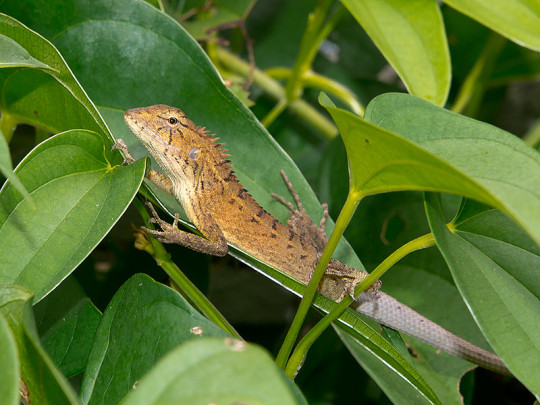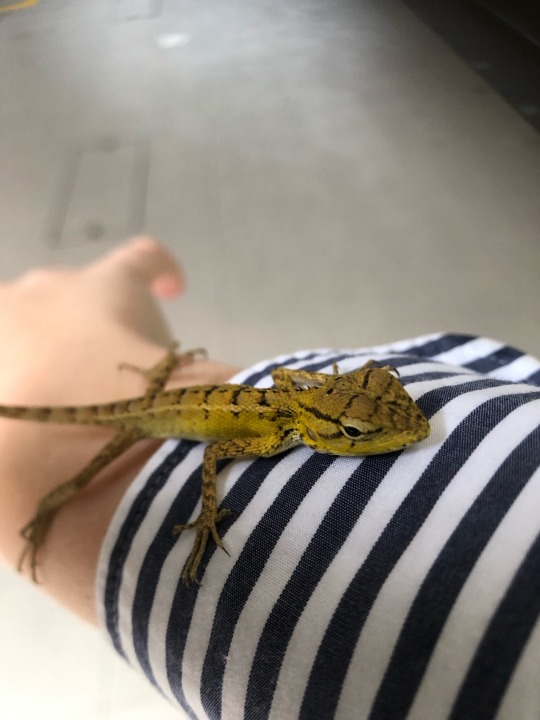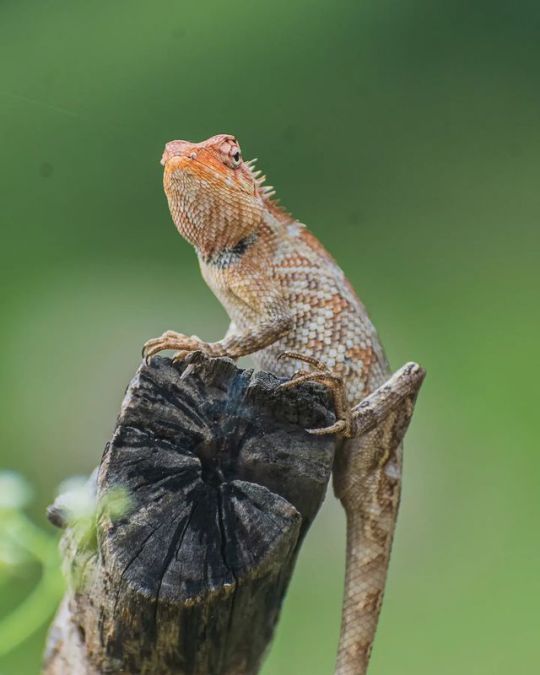#calotes versicolor
Text

An Oriental garden lizard (Calotes versicolor) in Thailand
by Eerika Schulz
#oriental garden lizard#agamids#lizards#reptiles#calotes versicolor#calotes#agamidae#squamata#reptilia#chordata#wildlife: thailand#wildlife: asia
48 notes
·
View notes
Text

??????????? hello
#little lady jumped onto my arm out of nowhere and promptly fell#* fell asleep#I put her on a tree after making sure she was alrigjt ^_^#oriental garden lizard#changeable lizard#calotes versicolor#lizard#check out her paretial eye!!!
34 notes
·
View notes
Text
A Lizard Moment

A Changeable Lizard in a tense moment in a northwestern wetland reserved. Photo credit: Jonathan Chua.
To run or not … I like to catch lizards in one of such postures. This was a tense moment for it as it assessed the threat. Armed with a contrast detection auto-focus system, I had to move very slowly lest it got spooked and ran away before I could take a shot.
#photographers on tumblr#Calotes versicolor#changeable lizard#flora fauna#lizard photos#lumix photography#panasonic lumix 100-300mm#panasonic lumix gx1#photography tips#wildlife photography#wildlife pics
14 notes
·
View notes
Text

Oriental Garden Lizard
35 notes
·
View notes
Text

Eastern Garden Lizard (Calotes versicolor), male, family Agamidae, found in SE Asia
photograph by AmarendraUkidwe
791 notes
·
View notes
Text

Common flying dragon (Draco volans) ; Oriental garden lizard (Calotes versicolor)
Reptiles and Amphibians of the World. Written by Hans Hvass. Illustrated by Wilhelm Eigener. Originally published in 1958.
Internet Archive
#reptiles#lizards#flying lizards#common flying dragons#forest lizards#oriental garden lizards#Wilhelm Eigener
89 notes
·
View notes
Text
A new iguana joins Asia's rich reptile fauna, officially described as new to science in the open-access journal ZooKeys.
"From 2009 to 2022, we conducted a series of field surveys in South China and collected a number of specimens of the Calotes versicolor species complex, and found that the population of what we thought was Calotes versicolor in South China and Northern Vietnam was a new undescribed species and two subspecies," says Yong Huang, whose team described the new species.
Wang's garden lizard (Calotes wangi) is less than 9 cm long, and one of its distinguishing features is its orange tongue.
Continue Reading.
61 notes
·
View notes
Text
21st of September 2024: Russell’s Kukri Snake

God, snakes can never have a simple taxonomic history, can they? Here is Russell’s Kukri Snake (Oligodon russelius). They’re at most 65 cm long and named after Patrick Russell, who was a British doctor [1], while the Kukri part of their name refers to the genus, who are named after their curved teeth, which resemble kukris, Nepali daggers [2].
Before we dive into taxonomies, here’s some background on them: they’re spread across northern, central, and eastern India, Nepal, and north eastern Pakistan [1], in deciduous jungle terrains. They have been observed to scavenge, willing to feed on dead garden lizards such as Calotes versicolor. They may also flatten the back of their head in order to intimidate potential predators [3].
Now originally the species name russelius was used for them in 1803. However, throughout the 20th century, they were considered synonymous with O. arnensis [1]. Then, in 2022 a paper found it most reasonable to revive the species based upon their body measurements and biogeography [3].
To confuse it a bit more, in 2021, a new species of snake was described, Oligodon churahensis [4], which was actually initially found via an Instagram post which then led scientists to further investigate [2]. Then, only two years later, a genetic analysis chose to combine them with the now resurrected Russell’s Kukri Snake [5].
Sources: [1] [2] [3] [4] [5] [Image]
#critter of the day#critteroftheday#snake saturday#snake species#snake#cw: snake#zoology#herpetology#animal#animal species#animal facts#taxonomy
3 notes
·
View notes
Text
Incredible Aliens - Lizards 🦎👽
All reptiles, birds and mammals including humans, descended from a single reptilian ancestor approximately 320 million years ago. Reptiles are our early ancestors.
Humans have this deep 320 million years old heritage. Even the most revered and feared reptilian alien on Earth, the snakes have evolved from lizards.
1. Indian chameleon (Chamaeleo zeylanicus)
2. Earless Agamid (Aphaniotis fusca)
3. Marbled Bent-toed Gecko (Cyrtodactylus quadrivirgatus)
4. Green Crested Lizard (Bronchocela cristatella)
5. Changeable Lizard (Calotes versicolor)
📸: UN Biodiversity via Instagram





2 notes
·
View notes
Text
Oriental Garden Lizard: Habitat, Behavior, and Conservation
The Oriental Garden Lizard (Calotes versicolor) is a captivating reptile, commonly found in South and Southeast Asia. Renowned for its vibrant colors and dynamic behavior, this common Asian lizard thrives in gardens, forests, and urban areas. Whether basking on tree trunks or displaying its red throat to attract mates, it embodies rich biodiversity. Moreover, its ability to blend into various…

View On WordPress
0 notes
Text
Le volontarie di Anpana recuperano un sauro della famiglia Agamidae, era in un containe proveniente dall'India
Le volontarie di Anpana recuperano un sauro della famiglia Agamidae, era in un containe proveniente dall'India
Livorno 14 giugno 2023 – Le volontarie di Anpana recuperano un sauro della famiglia Agamidae, era in un containe proveniente dall’India
Nel pomeriggio di oggi Anpana è stata chiamata dai lavoratori dall’Agenzia Marittima Casali perche in un container proveniente dall’India hanno trovato un Calotes Versicolor (agamidae no cities)
Le volontarie di ANPANA recatesi sul posto lo hanno…

View On WordPress
0 notes
Text



a clutch of eastern garden lizard eggs just hatched last week (and i actually found the eggs half buried in the ground!) so these tiny baby lizards have been ALL over my plants, they're such a delight. this one snuck into the house this morning and i didn't see it leave until now!
i generally don't expect garden lizard hatchlings after june/july so this clutch was such a pleasant surprise - and it couldn't have come at a better time, seeing as the in-house lizard killer (my cat) has been hunting adult lizards left and right and bringing them to me as presents. she gets very upset when i bury them lol. this is only one of around 7-8 baby lizards from the clutch! i hope i get to see them all grow up 🦎
#vaaya moodu#wildlife tag#eastern garden lizard#oriental garden lizard#calotes versicolor#fun fact these are also called bloodsuckers but the name is SO misleading
8 notes
·
View notes
Photo

Oriental Garden Lizard (Calotes versicolor) by Laval Roy
47 notes
·
View notes
Photo




ஓணான் | Oriental garden lizard
An Oriental Garden Lizard can change its colors to suit a situation, mostly as a camouflaging mechanism. It assumes the color of the surface it is on. This trait gives it its scientific name Calotes versicolor, where ‘versicolor’ has been derived from the Latin words verso (“turn”) and color (“color”). It is a natural biological pest controller that keeps a check on the insect population in the ecological system.
Oriental Garden Lizards are vertebrates, meaning they have a spine or a backbone. Their usual foraging technique is to sit and wait, where they spend most of their time perched in one location waiting for their prey to pass. Then, with a quick burst of speed, they sprint after their prey, snatching them up with their tongues.
One serious threat to these natural pest controllers is the use of insecticides and pesticides in our gardens. These chemical-laden insecticides often kill their prey base which either forces them to move to a different territory or die after ingesting these infected insects.
MORE AT
CREDIT | KANTHAVEL ( kv photography )
1 note
·
View note
Text

Eastern Garden Lizard (Calotes versicolor), male, family Agamidae, found in SE Asia
photograph by Sifat Sharker
381 notes
·
View notes
Text

Grzimek's Animal Life Encyclopedia. Volume 6: Reptiles. Written by Bernard Grzimek. 1984.
1.) Moluccan sail-finned lizard (Hydrosaurus amboinensis)
2.) Common flying dragon (Draco volans)
3.) Australian water dragon (Intellagama lesueurii)
4.) Cophotis sumatrana
5.) North African spiny-tailed lizard (Uromastyx acanthinura)
6.) Oriental garden lizard (Calotes versicolor)
7.) Common agama (Agama agama)
8.) Eastern bearded dragon (Pogona barbata)
9.) Sunwatcher Agama (Phrynocephalus helioscopus)
10.) Thorny devil (Moloch horridus)
#reptiles#lizards#Moluccan sail-finned lizard#common flying dragon#australian water dragon#North African spiny-tailed lizard#oriental garden lizard#common agamas#bearded dragons#sunwatcher agamas#thorny devils
370 notes
·
View notes